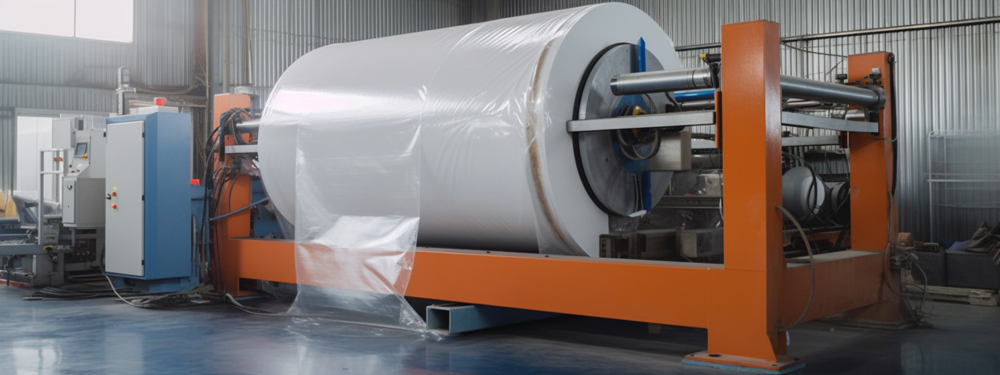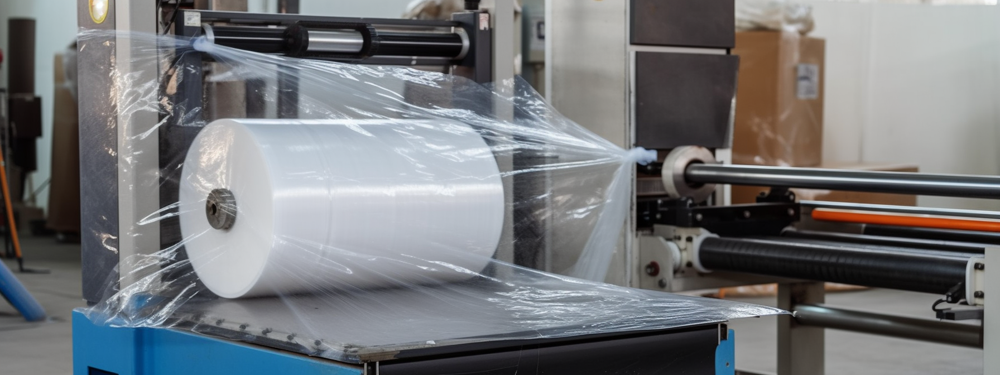Wrap it up and put a bow on it – but make sure you’re following the proper safety guidelines for using machine stretch film! Whether you’re wrapping packages for work, sending gifts to loved ones, or just trying your hand at crafting, we’ve got you covered with our cheerful Safety Guidelines. From tips on handling the film to advice on using the machine itself, our guide will help you wrap with ease and a smile. So let’s get started and make sure all of your packages are delivered safely and securely!
Safety Guidelines for Using Machine Stretch Film:
- Always wear appropriate personal protective equipment (PPE) such as gloves, eye protection, and ear protection when using a stretch film machine.
- Ensure that the machine is installed and maintained properly according to the manufacturer’s instructions.
- Familiarize yourself with the controls and features of the machine before use.
- Never leave the machine unattended while it’s in operation.
- Make sure the film roll is properly loaded onto the machine and that it’s the correct size and type for the job.
- Avoid touching the film with your bare hands as this can cause static electricity buildup.
- Keep the work area clean and clear of obstacles to avoid accidents.
- Always follow safe lifting techniques when moving heavy objects around the machine and while changing the film roll.
- Don’t exceed the maximum weight capacity of the machine or the film roll.
- Turn off the machine and unplug it from the power source before performing any maintenance or cleaning tasks.
Remember, following these Safety Guidelines will not only ensure your safety but also result in perfectly wrapped packages every time.

Our guide is jam-packed with tips and tricks to make wrapping a fun and stress-free experience! From choosing the right size of film to mastering the art of the perfect wrap, we’ll take you through every step of the process with a smile. So don’t wait – read on to learn more about how you can spread joy and happiness with perfectly wrapped packages, using our Safety Guidelines as your trusty companion!
What roller skating bearings are and their importance in the sport
Machine stretch film is a type of packaging material typically made from polyethylene plastic and designed to be used with a stretch film machine. It is used to wrap around and secure items on pallets or other types of packaging, providing protection and stability during storage and transportation. The stretch film machine applies tension to the film as it’s dispensed, stretching it up to 300% of its original length, which allows it to conform tightly to the shape of the item being wrapped. This creates a tight seal that keeps the item in place and protects it from damage caused by shifting, scratches, dust, moisture, and other hazards during transit. Machine stretch film is available in a variety of thicknesses, widths, and colors to suit different applications and preferences.
Safety Guidelines for Using Machine Stretch Film
Safety Guidelines for using machine stretch film are crucial to ensure a safe and efficient working environment. Here are some general guidelines to follow when using a stretch film machine:
- Always wear appropriate personal protective equipment (PPE) such as gloves, eye protection, and ear protection when using the machine.
- Ensure that the machine is installed and maintained properly according to the manufacturer’s instructions.
- Familiarize yourself with the controls and features of the machine before use.
- Never leave the machine unattended while it’s in operation.
- Make sure the film roll is properly loaded onto the machine and that it’s the correct size and type for the job.
- Avoid touching the film with bare hands as this can cause static electricity buildup.
- Keep the work area clean and clear of obstacles to avoid accidents.
- Always follow safe lifting techniques when moving heavy objects around the machine and while changing the film roll.
- Don’t exceed the maximum weight capacity of the machine or the film roll.
- Turn off the machine and unplug it from the power source before performing any maintenance or cleaning tasks.
By following these Safety Guidelines, workers can help prevent accidents and promote a safe working environment when using machine stretch film.

Risk Assessment and Identification of Hazards
Risk assessment and identification of hazards are vital steps in ensuring workplace safety when using a machine stretch film. Here are some common risks and hazards associated with machine stretch film:
- Physical hazards: These include cuts, bruises, and pinch points that can occur during the operation of the machine or while handling the film roll.
- Chemical hazards: The polyethylene plastic used to make the film can be hazardous if ingested or inhaled, and can also cause skin irritation or allergic reactions.
- Tripping hazards: Film rolls or other materials lying on the floor can create tripping hazards for workers in the area.
- Electrical hazards: The stretch film machine requires electricity to function, and workers need to be mindful of electrical hazards such as frayed wires or improperly grounded outlets.
- Ergonomic hazards: Repetitive motions required to load the machine and handle heavy objects can lead to ergonomic hazards such as strains or sprains.
To identify these hazards and assess the associated risks, it’s important to conduct regular inspections of the work environment, equipment, and processes. This can involve reviewing manufacturer instructions and conducting employee training to ensure proper use and handling of the stretch film machine. By identifying potential hazards and taking proactive steps to minimize risks, workplaces can help prevent accidents and promote a safe and productive working environment.
Personal Protective Equipment (PPE)
Personal Protective Equipment (PPE) is equipment worn to minimize exposure to various hazards that may cause injury or illness. Here are some examples of PPE and their uses:
Gloves
Gloves are used to protect the hands from cuts, punctures, and other injuries when handling sharp objects or working with hazardous materials. Different types of gloves are available for different applications, such as nitrile gloves for handling chemicals or cut-resistant gloves for working with knives.
Eye and Face Protection
Eye and face protection are designed to protect the eyes and face from flying debris, dust, chemicals, and other hazards. Examples of eye and face protection include safety glasses, goggles, face shields, and welding helmets.
Footwear
Footwear is designed to protect the feet from slipping, falling objects, chemical spills, and electrical hazards. Safety footwear can be made of materials like reinforced steel and composite materials to provide additional protection against impact and puncture.
Clothing
Protective clothing is used to protect the skin and body from exposure to harmful substances, extreme temperatures, and other hazards. Examples of protective clothing include aprons, lab coats, and coveralls made from materials like Tyvek or Kevlar.
It’s important to select the appropriate type of PPE for the specific hazards encountered in a particular work environment. Workers should receive training on how to properly use and maintain their PPE to ensure maximum effectiveness. Properly using PPE can help prevent workplace accidents and promote a safe working environment.
Safe Operation Practices
Safe operation practices are essential to ensure a safe and efficient working environment when using a machine stretch film. Here are some examples of safe operation practices:
Training on Proper Use of Machine
Anyone who uses a machine stretch film should receive proper training on how to use it safely and effectively. This includes understanding the controls, features and safety procedures associated with the machine.
Machine Maintenance and Inspections
Regular maintenance and inspection of the machine is crucial for keeping it in good condition and preventing accidents. This includes keeping the machine clean, checking for frayed wires or other damage and ensuring that all safety features are functioning properly.
Safe Loading and Unloading of Stretch Film Rolls
When loading or unloading stretch film rolls onto the machine, it’s important to follow safe lifting techniques to avoid strains and sprains. Make sure to lift with your legs, not your back, and avoid twisting or bending at the waist.
By following these safe operation practices, workers can help prevent accidents and promote a safe working environment when using machine stretch film.
Hazard Communication
Hazard communication is the process of conveying information about hazardous substances or materials in the workplace to ensure worker safety. Here are some examples of hazard communication tools:
Labels and Signs
Hazardous materials must be labeled appropriately to warn workers of potential hazards. Labels should include information such as the name of the substance, the hazard warning, and instructions on safe handling and disposal.
MSDS (Material Safety Data Sheet)
MSDS is a document that provides detailed information about the physical and chemical properties of a hazardous substance, as well as its potential health effects and safe handling procedures. MSDS sheets should be made available for all hazardous materials used in the workplace.
By using labels and signs and providing MSDS sheets, workers can become informed about potential hazards in the workplace and take appropriate precautions to protect themselves. It’s important to follow all labeling requirements and to ensure that MSDS sheets are up to date and readily accessible to workers. Hazard communication is an essential element of any workplace safety program, and it helps to promote a safe working environment for everyone.

Response to Injuries or Accidents
Response to injuries or accidents is an important part of workplace safety when using machine stretch film. Here are some examples of response measures:
First-Aid Measures
In the event of an injury or accident, it’s important to provide first-aid measures immediately. This may include cleaning and dressing wounds, immobilizing fractures or sprains, or administering CPR or other life-saving measures if necessary.
Reporting Incidents
All incidents, including near-misses, should be reported as soon as possible. This provides a record of what occurred and helps identify potential hazards that need to be addressed. It also allows for corrective action to be taken to prevent similar incidents from occurring in the future.
By providing prompt first-aid measures and reporting incidents, workers can help prevent further injury and promote a safe working environment. Employers should have a clear protocol in place for reporting and responding to incidents, and workers should receive training on these procedures to ensure they can act quickly and appropriately in case of an emergency.
Fire Prevention and Control Measures
Fire prevention and control measures are important to ensure workplace safety when using machine stretch film. Here are some measures that can be taken to prevent and control fires:
Regular Maintenance
Proper maintenance of the stretch film machine and electrical equipment can help prevent malfunctions that can lead to fires.
Fire Extinguishers
Fire extinguishers should be readily available in the work area, and workers should be trained on how to properly use them.
Clear Work Area
Keep the work area free of clutter and combustible materials to prevent the spread of fires.
Smoking Prohibitions
Smoking should be prohibited in areas where machine stretch film is being used, as it presents a fire hazard.
Emergency Response Plan
An emergency response plan should be in place in case of a fire or other emergency. This includes procedures for evacuating the building and contacting emergency services.
By following these fire prevention and control measures, workers can help prevent workplace fires and protect themselves and their colleagues. It’s important to be aware of potential fire hazards and take proactive steps to minimize risks.
Conclusion

In conclusion, Safety Guidelines for using machine stretch film are essential in ensuring a safe and productive working environment. By following simple guidelines like wearing appropriate PPE, properly loading the film roll, and conducting regular maintenance and inspections on the machine, workers can prevent accidents and promote safety. Implementing these safety guidelines not only promotes safety but also leads to a more efficient and productive work environment. Remember to always follow safety guidelines when using machine stretch film to ensure the safety of yourself and others.













